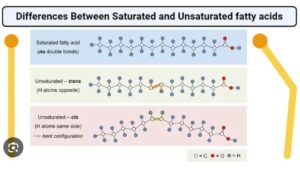
It seems that for a long time there has been a bit of a stigma around the word ‘fat’ and that it’s not exactly considered a best friend when it comes to food. While this is true of some fats, there are others that are hugely important to your diet and health. It might be a case having which-is-which around the wrong way! To this end, we thought it’d be a good idea to break down this complex topic and dispel some of the myths around fats to let you know why it’s so vital you include them in your diet.

Fatty acids, saturation, and chains
Because fatty acids (FAs) are essential to life on earth, every food we eat will contain fat, even if, in the case of some fruits, the amount is around 0.001%. And every fat in every food will be a combination of saturated (SFA), monounsaturated (MUFA), and polyunsaturated (PUFA) fatty acids, in varying ratios. There are no solely saturated fats and no solely mono- or polyunsaturated ones. There is a myriad of short, medium, and long-chain FAs, within the 3 levels of saturation, e.g., stearic, palmitic, lauric, butyric, linoleic, arachidonic (Omega-6), and docosahexaenoic (DHA—Omega-3), to name but a few! Stearic, palmitic, myristic, lauric, caprylic, and butyric acid are examples of saturated FAs, with the long-chain palmitic acid (C16:0) being the body’s most common and preferred “storage” form of fat. Butyric acid (C4:0), or butyrate, is a well-known short-chain FA found in butter and ghee (small amounts), which is also made by gut bacteria to feed the cells of the gut lining. Lauric acid (C12:0) is the most common FA in coconut oil and is a medium-chain FA.
The Omega 3 and 6 fats
The omega-6 and 3 FAs are considered essential because we cannot make them in our body. Omega 3 appears to have a positive effect on our cardiovascular health, and it also is very good at supporting a healthy immune response. Omega-6 FAs are considered to be problematic, but arachidonic acid (C20:4) is actually essential, and it performs many jobs in the body. We do not actually require a huge amount of these fatty acids, except in childhood or when pregnant. It is more important that the ratio of omega 6 to 3 is in a healthy range—between 1:1 and 4:1—but studies suggest that a typical Western diet contains a ratio of around 16:1 or even higher.
A saturated fat…
…is so-called because, at a molecular level, the carbon bonds are fully “saturated” with hydrogen atoms. This makes saturated fatty acids generally firm and solid at room temperature, not prone to oxidation, and very stable to cook with. Saturated fats will not “clog your arteries,” not least because our bodies are too warm for any fat to remain solid! The most stable fats are the ruminant (cow, sheep, etc.) fats like tallow, suet, and the fat on red meat. Butter and ghee are also highly saturated and very stable, although the milk proteins left in butter can cause the butter to burn when frying. To call animal fats “saturated” is to ignore the monounsaturated and polyunsaturated components of the fat as a whole. For example, beef fat is, on average, nearly 50% saturated, but also approximately 45% monounsaturated and 5% polyunsaturated—a perfect ratio for human health. Suet, the prized fat around the kidneys, contains a high amount of stearic acid, a fat that is strongly linked to healthy weight and lean body mass. Butter has been shown to increase available energy even up to 8 hours after a meal, contributing to healthy weight. It’s no wonder that in primitive human populations that use butter, it is viewed as a sacred food.
Contrast that with unsaturated fats,
which are usually liquid at room temperature, prone to oxidation, and very unstable. We know them as fruit oils like olive and avocado, or seed/vegetable oils like flaxseed oil, soybean, rice bran, and canola, but again, they are not solely unsaturated—they also contain a ratio of saturates to unsaturates. Olive oil is a fruit-derived lipid (fat) and is approximately 73% monounsaturated, 14% saturated, and 11% polyunsaturated. Surprisingly, coconut oil, a fruit oil, is the most saturated fat in the food kingdom, with around 90-92% saturated, 6-8% monounsaturated, and the balance, polyunsaturated.
Just to confuse things, polyunsaturated fats also include the essential fatty acids, docosahexaenoic acid (DHA—C22:6 [n-3]), eicosapentaenoic acid (EPA—20:5 [n-3]), and arachidonic acid (AA, or ARA). As already discussed, the omega fatty acids are essential because we cannot make them in our body, and we have to obtain them from our diet. The most important of these long-chain fatty acids are AA and DHA. The omega-3s, DHA and EPA, and omega-6, AA, are only found in animal foods. The plant forms of omega 3, alpha-linolenic acid, and omega 6, linoleic acid, are poorly converted to the useable forms in most of us. Algal oils do contain DHA, EPA, and AA, but they are still in a form that we also need to convert in our body, so they are not a completely reliable substitute for animal fats in the diet.
Weird science
For a while now, due to incomplete and inaccurate science undertaken in the middle of last century, the thinking has been that there was a benefit to using unsaturated vegetable oil over saturated fat because it is “better for heart and cardiovascular health.” This was because eating unsaturated oils “lowers cholesterol levels in the blood.” We now know that cholesterol is not the cause of problems, in and of itself. Cholesterol is vital for all animal life, and our body makes the bulk of the cholesterol we need.

What makes polyunsaturated oils…
…more dangerous to our heart health is that when they are heated, the oil oxidises, producing free radicals, which can damage arteries and cells. They’re called vegetable oils, but they have little to do with vegetables, as such. They are extracted from seeds, and most are industrially processed oils, the process creating toxic chemicals within the oil. Hydrogenated oil, found in margarines, etc., is altered to behave like a saturated fat—to be solid at room temperature—and is the most dangerous because it becomes a trans fat. While a very small amount of cold-pressed, organic seed oil is ok, ditch the margarine and stick to butter! Use other animal fats for cooking, and save the olive oil and whole avocado for salads, mayos, etc.
Another reason vegetable oils should be avoided is because they contain relatively high levels of linoleic acid (LA-18:2 [n-6]), an omega-6 fatty acid. Small amounts are present in traditional foods, but with vegetable oils in almost all processed foods, our modern diets are far too high in LA. The issue with excess LA is complicated, but the main problems are how easily it oxidises, how it competes with omega-3s for metabolism, its harmful breakdown products (OXLAMS and aldehydes), and how it hijacks satiety levels through cannabinoid receptor activation in the proximal small intestine. The fat tissue and cellular membranes of obese humans have been shown to contain much higher levels of LA than those with normal fat mass.
Vegetable oils also contain phytosterols, which compete with cholesterol for use in the body. Cholesterol is essential for life, and around 80% of cholesterol is made in the liver. Cholesterol is so important that the brain makes its own. Coconut oil is very stable to cook with because it is highly saturated; however, being a plant oil, it does contain phytosterols, albeit at much lower levels than seed oils. Coconut oil is by far the safest plant oil to cook with.
Fat for fuel

Fats can be utilised as a fuel, just like glucose, but in a different way in our mitochondria (cell powerhouses). A healthy metabolism is not overloaded with energy and is able to switch between these 2 fuel sources (and the other two substrates, ketones and lactate). Glucose is thought to be the main fuel utilised during waking hours and for “explosive,” fast movement, whereas fat is preferentially “burned” during sleep and during endurance-type activities, but a healthy metabolism should be able to swap between them relatively easily. Fat can also be utilised in the form of ketones, but that is a topic for another day! The key thing to remember is that if you are not eating ultra-processed foods or much in the way of refined oils and sugar, so that you are keeping your insulin within normal levels, you should be able to switch between fuel sources with ease.
The final skinny on fat
The important thing to remember is that fats are an important part of our diet and should be eaten in whole food form, not in the form of industrially produced oils. Eating natural, animal fats from land and sea animals is not bad and, in fact, could be the very thing that made us human. They contain the essential fat-soluble vitamins A, C, D, and E, in the forms that our bodies require, and are very stable and contain many little-known, healthy fatty acids like CLA and trans-vaccenic acid, and odd-chain FAs like C15.
Dietary fat is a much more complex and nuanced topic than most healthcare providers would have you believe. To make things simpler, avoid vegetable oils, especially if they’re hydrogenated, as much as possible. These are the fats you would find in processed and junk “foods.” Deep-fried foods should be avoided at all costs due to the toxic nature of the vegetable oils when they are heated. If you can find a takeaway bar that still uses highly stable beef tallow or pork lard (any kind of meat dripping or rendered fat) to fry with, that is a much healthier choice. At the end of the day, don’t fear the natural fat, just the oil!
